Coaching Clinical Teams Module
Slide 1: Coaching Clinical Teams Module

Slide 2: Objectives

The objectives are listed as a series of steps:
Understand current team training in the health care setting
Describe coaching in the clinical environment
Outline benefits of coaching
Identify the characteristics of a good coach
Demonstrate coaching steps when giving feedback to a team
Describe how an observation tool can improve performance
Slide 3: Overview

- Coaching Defined.
- Providing Constructive Feedback to Teams.
- Putting Coaching Into Action.
- Observation Tools as Coaching Resources.
Slide 4: Coaching Defined

This section covers—
- Teaching in the health care setting.
- Using coaching as an alternative approach to teaching in the health care setting.
- Overview of coaching.
- Benefits of coaching.
- Characteristics of a good coach.
Slide 5: Standard Approach to Training in the Health Care Setting

- Manual or procedure guide.
- Lecture with PowerPoint presentation .
- Individuals are expected to change.
- Little followup or change.
Image: clip art of a report
Slide 6: Applying Health Care Training to Driving Instruction

- A driver's manual.
- A PowerPoint presentation.
- The car keys and the freeway.
Images: clip art of a report; clip art of car keys and clip art of someone driving a car
Slide 7: How We Really Teach Someone To Drive

- A driver's manual.
- A PowerPoint presentation.
- An introduction to the car.
- Lots of practice and driving with a "coach".
- Driving alone.
Images: clip art of a report; clip art of a car with a driver and a passenger and clip art of a car with a driver
Slide 8: An Alternative Approach to Teaching in Health Care – Coaching

Three steps of coaching, listed in boxes with an arrow pointing to the next box
Teach Me/ Show Me
Watch Me
Give Me Feedback
Slide 9: Overview Of Coaching

Coaching is—
- Listening and watching.
- Asking questions.
- Getting the team to—
Image: clip art of medical professionals standing in a small group listening to someone talk.
Slide 10: Overview Of Coaching (continued)

Coaching is not—
- Telling2
- Criticizing
- Instructing/teaching
Image: clip art of someone speaking with their hands on either side of their mouth to amplify their voice.
Slide 11: Benefits of Coaching Teams

- Better patient care3
- Better morale
- Better functioning team
- Motivates individuals and teams to make changes3,1
- Identifies safe practices and areas where you may want to focus future quality improvement efforts4
Image: clip art of a medical team raising their hands to answer questions from an instructor.
Slide 12: Traits of a Coach

A coach should be someone who is—
- Coachable
- Trusted and respected by their peers1
- An excellent communicator and listens respectfully
- Knowledgeable of the clinical environment
- Trained at giving feedback2
Slide 13: Giving Constructive Feedback to Teams

This section covers—
- How feedback is usually given in the health care environment.
- The basics of giving constructive feedback.
- The power of asking questions.
- Examples of using the three-part question to coach teams.
Slide 14: How Feedback Is Often Given in the Health Care Setting
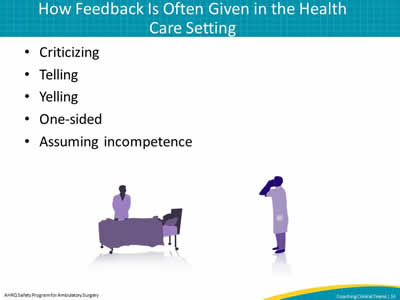
- Criticizing
- Telling
- Yelling
- One-sided
- Assuming incompetence
Images: clip art of patient in bed and provider standing next to the bed and
clip art of provider speaking with hands on either side of the mouth to amplify the voice.
Slide 15: Key Components of Feedback
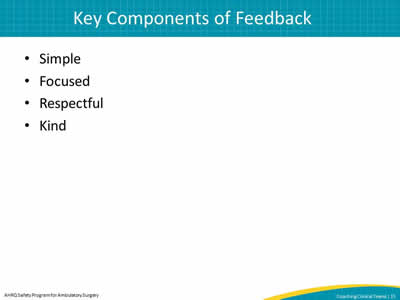
- Simple
- Focused
- Respectful
- Kind
Slide 16: Coach by Asking Questions

- Your audience consists of knowledgeable adults.
- Team members benefit from—
- reflecting on what has happened.
- identifying their own solutions.
- The role of a coach is to guide, not to tell.
Slide 17: Components of the Three-Part Question

Each component is listed in a box, with an arrow pointing to the next box
1. Your observation:
"I saw…"
2. Your opinion:
"I think that it is important to…"
3.Your question:
"I wonder…"
Slide 18: Part I: Your Observation
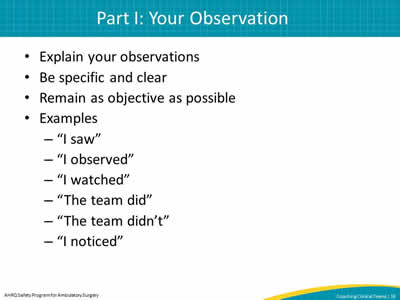
- Explain your observations.
- Be specific and clear.
- Remain as objective as possible.
- Examples
- "I saw"
- "I observed"
- "I watched"
- "The team did"
- "The team didn't"
- "I noticed"
Slide 19: Part II: Your Opinion

- Share why you are focusing on a specific behavior or action and explain its importance.
- Examples
- "I think…"
- "I believe…"
- "It is really important to…"
- "I am pleased because…"
- "I am concerned because…"
Slide 20: Part III: Your Question

- Allows the team to reflect.
- Displays genuine curiosity and interest in what happened.
- Examples
- "Can you help me understand?"
- "I am curious, what do you think happened?"
- "How did that make you feel?"
- "What is your point of view?"
- "How did you experience that?"
- "I wonder what you think happened?"
- "Where do you think your team was coming from?"
Slide 21: The Three Parts Together

- "I noticed that the team did not debrief at the end of the case."
- "I think that debriefing is really important."
- "Can you help me understand why that didn't happen?
Slide 22: Avoid Making Generalizations

- Example of generalization
- "I noticed that communication wasn't very good. I think that having good communication is important. Can you help me understand what happened?"
- Instead, give the team specific examples of what you saw
- "I noticed that your team didn't use the checklist on the wall to prompt your discussions. I believe reading off of the checklist helps so that all items on the checklist are discussed. I'm curious why you didn't read the items on the poster."
Slide 23: Avoid Assuming You Understand People’s Actions

- Example of assuming you understand people's actions
- "I noticed that you skipped the introductions because you were in a hurry."
- Instead say this
- "I noticed that your team skipped the introductions. I think they're an important part of the checklist because it gives everyone a chance to say something before the start of the case. Can you tell me why you skipped them?"
Slide 24: Avoid Making the Team Guess What You Are Thinking
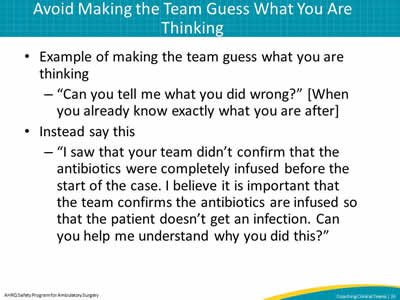
- Example of making the team guess what you are thinking
- "Can you tell me what you did wrong?" [When you already know exactly what you are after]
- Instead say this
- "I saw that your team didn't confirm that the antibiotics were completely infused before the start of the case. I believe it is important that the team confirms the antibiotics are infused so that the patient doesn't get an infection. Can you help me understand why you did this?"
Slide 25: Avoid Asking Questions That Already Contain the Answer
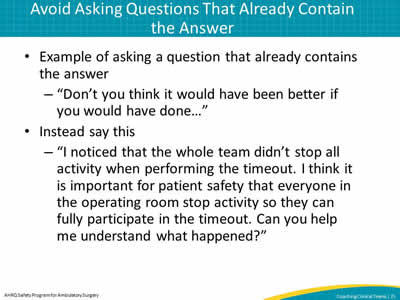
- Example of asking a question that already contains the answer
- "Don't you think it would have been better if you would have done…"
- Instead say this
- "I noticed that the whole team didn't stop all activity when performing the timeout. I think it is important for patient safety that everyone in the operating room stop activity so they can fully participate in the timeout. Can you help me understand what happened?"
Slide 26: Avoid Disguising a Statement as a Question

- Example of disguising a statement as a question
- "You didn't really want to do that, did you?"
- Instead say this
- "I saw that your team didn't review the specimen labeling before the patient left the room. I believe it is important to read back the specimen labeling, including the patient's name, so that there is no confusion over what the specimen is. I am curious, what do you think happened?"
Slide 27: Avoid Singling Out Individuals When Coaching the Team
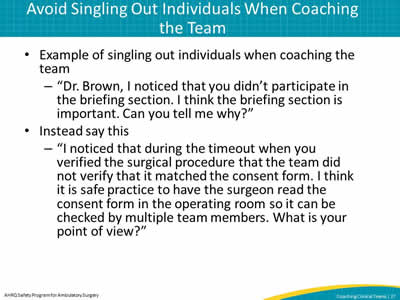
- Example of singling out individuals when coaching the team
- "Dr. Brown, I noticed that you didn't participate in the briefing section. I think the briefing section is important. Can you tell me why?"
- Instead say this
- "I noticed that during the timeout when you verified the surgical procedure that the team did not verify that it matched the consent form. I think it is safe practice to have the surgeon read the consent form in the operating room so it can be checked by multiple team members. What is your point of view?"
Slide 28: Putting Coaching Into Action

This section covers—
- Planning your coaching day.
- Giving feedback at the appropriate time.
- Steps you should take when giving feedback to teams
- Step I: Set the stage.
- Step II: Start with an open-ended question.
- Step III: Share your observations with the team using the three part question.
- Step IV: Motivate the team by focusing on what they could do better.
- Step V: End the coaching session.
Slide 29: Planning Your Coaching Day

- Pick the appropriate cases to coach.
- Coach on days when the team will have time to talk.
- Prepare the team for your coaching session.
Slide 30: When To Coach in the Clinical Setting
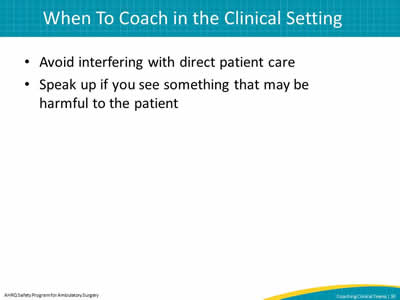
- Avoid interfering with direct patient care.
- Speak up if you see something that may be harmful to the patient.
Slide 31: Questions Coaches Need To Ask Themselves Before Coaching The Team’s Performance

- What is the team doing?
- Do I need to coach the team or an individual?
- Will coaching be effective for this team?
- What happened during the case?
Slide 32: Giving Feedback to the Team: Step 1 – Setting the Stage

- Thank the team for letting you observe.
- Frame the coaching session by telling the team the purpose is to improve patient care by enhancing their performance as a team.
Image: Video icon
Click to play
Select to play video: https://youtu.be/hk-3S5sQVmQ
Slide 33: Giving Feedback to the Team: Step 2 – Start With an Open-Ended Question

- Ask "How did the last case go?"
- This allows team members to say what is on their minds so you can direct the conversation where you would like it to go
Image: Video icon
Click to play
Select to play video: https://youtu.be/9C1cvna5NAg
Slide 34: Giving Feedback to the Team: Step 3 – Share Observations Using the Three-Part Question
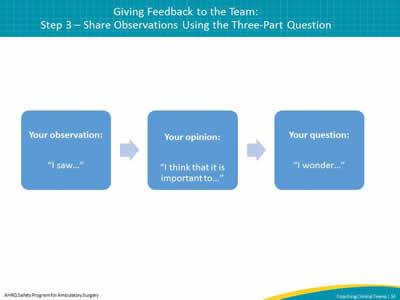
Image: Each part of the three-part question is listed in a box, with an arrow pointing to the next box
Your observation:
"I saw…"
Your opinion:
"I think that it is important to…"
Your question:
"I wonder…"
Slide 35: Coaching Using Three-Part Question
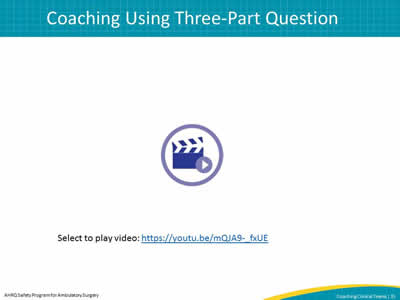
Image: Video icon
Click to play
Select to play video: https://youtu.be/mQJA9-_fxUE
Slide 36: Giving Feedback to the Team: Step 4 – Motivate the Team by Focusing on What It Could Do Better

- Gives teams the chance to look at what went well and what can be improved upon.
- Use a two-part technique for helping the team focus3
- First, the team discusses what the team did well.
- Second, the team identifies opportunities for improvement and discusses how to implement them in the future.
Slide 37: Motivating the Team
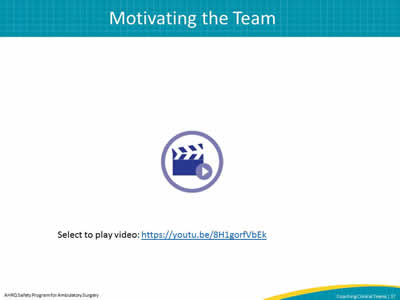
Image: Video icon
Click to play
Select to play video: https://youtu.be/8H1gorfVbEk
Slide 38: Giving Feedback to the Team: Step 5 – Ending the Coaching Session
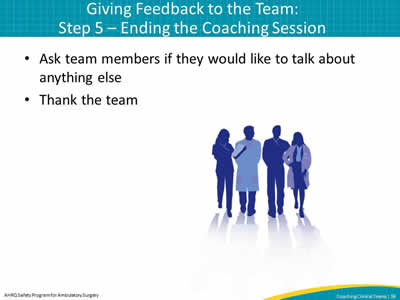
- Ask team members if they would like to talk about anything else.
- Thank the team.
Image: clip art of medical team
Slide 39: Ending the Coaching Session

Image: Video icon
Click to play
Select to play video: https://youtu.be/88t46tAXUVE
Slide 40: Observation Tools as Coaching Resources

This section covers—
- Benefits of using an observation tool.
- How to use an observation tool when coaching a team.
- Coaching resources.
Image: clip art of a clip board with a checklist on it.
Slide 41: Benefits of Using an Observation Tool
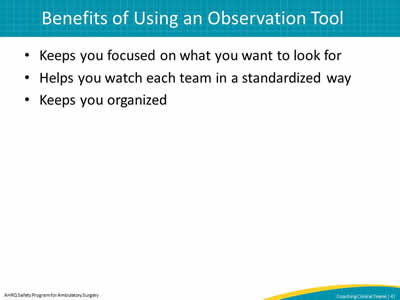
- Keeps you focused on what you want to look for.
- Helps you watch each team in a standardized way.
- Keeps you organized.
Slide 42: How To Use an Observation Tool

- Tell the team about the observation tool and explain its purpose beforehand.
- An observation tool can be filled out during the case or immediately after.
- Avoid writing down personal identifiers.
Image: clip art of a clipboard with a checklist on it.
Slide 43: Summary

- Coaching can improve patient care.
- Pick the appropriate people to be coaches.
- Train coaches on how to give feedback.
- Plan the coaching day ahead of time.
- Observation tools can help a coach give feedback.
Image: clip art of medical team raising hands to answer questions from an instructor.
Slide 44: Tools
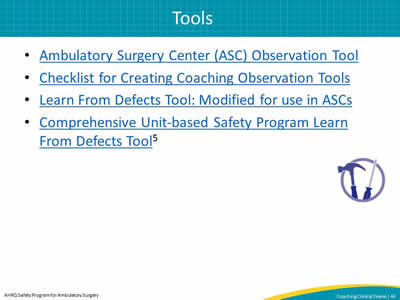
- Ambulatory Surgery Center (ASC) Observation Tool
- Checklist for Creating Coaching Observation Tools
- Learn From Defects Tool: Modified for use in ASCs
- Comprehensive Unit-based Safety Program Learn From Defects Tool5
Image: Tools icon with hammer and screwdriver.
Slide 45: References

- TeamSTEPPS Fundamentals Course: Module 9. Coaching Workshop: Instructor's Materials. November 2008. Agency for Healthcare Research and Quality, Rockville, MD.
- Knight J. Coaching: The key to translating research into practice lies in continuous, job-embedded learning with ongoing support. Journal of Staff Development. 2009 Dec 1;30(1):18-22.
- Rudolph JW, Simon R, Rivard P, et al. Debriefing with good judgment: combining rigorous feedback with genuine inquiry. Anesthesiol Clin. 2007 Jun;25(2):361-376. PMID: 17574196.
- Marilyn, PC, Moore Joseph. Learning in the thick of it. Harv Bus Rev. 2005 Jul-Aug;83(7):84-92, 192. PMID: 16028819.
- Learn From Defects Tool. CUSP Toolkit. December 2012. Agency for Healthcare Research and Quality, Rockville, MD.



